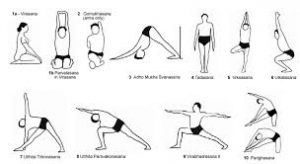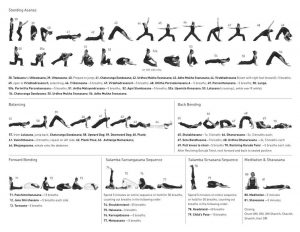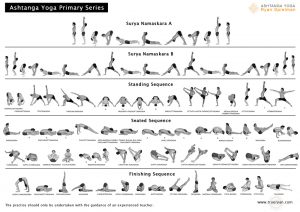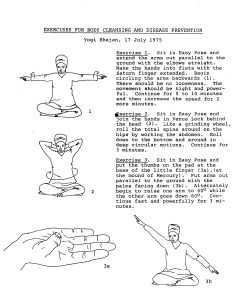There’s a smörgåsbord of yoga styles out there and the best approach to find your perfect fit is to get stuck in – it’ll only be a matter of time before you find your One (or two, or three…). Here’s a journey through the yoga styles as mapped out by my own experience. And ending, of course, with my favourite.
So, first things first, Hatha is the umbrella word for bendy yoga styles. Ha = sun, tha = moon, Hatha = balance/union between the two opposites – and it’s what all yoga does for you: unites your body and mind, yin and yang, masculine and feminine, light and dark. A hatha class is general yoga, and it’s divided further into these different yoga styles…
 Bikram / hot – the bikini babe
Bikram / hot – the bikini babe
For those who love to holiday in hot climates, then Bikram/hot yoga is just up your beach. In fact, you don’t need to wear any more than a bikini and many Bikramites are happy to stretch out their limbs in just that. Hot yoga is practiced in a specialised (and usually very expensive to enter) studio that’s heated to 40°C, with humidity pitched at 40 percent. The theory is that warm muscles are flexible muscles, so you are encouraged to stretch to the max in a Bikram class. Prepare to sweat. Take a towel in with you and have another towel spare for your post-gym shower. The 26 standard hatha yoga postures are repeated in the same sequence in every session, with hot yoga devotees swearing by their detoxifying, strengthening, toning benefits.
While many have jumped whole-heartedly into the Bikram/hot yoga craze, others are less eager to glamourise it, claiming that heating the muscles and joints to such a degree can cause hypermobility and hyperflexibilty, as well as dehydration and overheating. Many (read: me) experience some form of nausea or dizziness in their first hot yoga class due to the extreme heat and humidity.
Bikram yoga is the brainchild of India’s National Yoga Champion (heehee!), Bikram Choudhury.
 Iyengar – the slow ‘n’ steady one
Iyengar – the slow ‘n’ steady one
If you’re a methodical type who likes everything to be done by the book, then Iyengar is your baby. Iyengar is the physiologist of the yoga scene, as each posture is precisely practiced, leaving little room for injury.
While Iyengar yoga usually focuses on a different theme for every class – whether that’s opening your hips, aligning your spine, strengthening your knees – one thing you’ll consistently find is that you’ll hold the position for a goodly while, usually a few minutes. This has its advantages, as it helps to align your body in the postures, and also gives you a deep understanding of how each posture works. Another aspect that sets Iyengar apart from the rest is that it uses props like chairs, blocks and belts. This yoga gets that we’re all different shapes and sizes, and so accommodates us if we can’t quite reach our toes in a forward bend, or twist our ankles around our ears.
Iyengar was developed by BSK Iyengar who left this world in 2014. His Ramamani Iyengar Memorial Yoga Institute (RIMYI) in Pune is run by his family.
 Jivamukti – the hipster
Jivamukti – the hipster
This relatively new member of the yoga gang is a bit of a hipster, bringing flavours from across various established strands of yoga and spirituality to its classes.
Created by New York yogis Sharon Gannon and David Life in 1984, it’s a kaleidoscope of movement, mantras and meditation, all seasoned with a splash of music that certainly helps to keep the tempo of the class up.
Expect a challenging, flowing sequence of postures, and don’t be surprised if you’re asked to do a headstand in your first session. Jivamukti is open to all levels, so you find your own groove within the alternatives offered by the teacher.
 Ashtanga – the full-power one
Ashtanga – the full-power one
If you’re a gym bunny who thinks that yoga is for sweat-shy pansies, get thee to an Ashtanga class. This is the power house of yoga styles and will challenge even the fittest of fiddles. Sweaty and strength-building, Ashtanga is yoga’s answer to a cardio and weights workout, with all the mind-calming, detoxifying and health-boosting benefits that yoga offers. Expect a specific sequence of postures known as the primary series sandwiched between your usual sun salutations and final relaxation. There’s a hearty balance of standing and seated postures, and you’ll spend around five long, deep breaths in each – the longest breaths in your life when you’re in chair pose.
Ashtanga hails from India’s Sri Pattabhi Jois who, until he left this world in 2009, continued to teach Ashtanga yoga at his Ashtanga Yoga Institute in Mysore. Some yoga schools offer traditional Mysore-style yoga, which is not for the faint-hearted. Tackle it only once you have at least some knowledge of Ashtanga’s primary series.
In an Ashtanga class, you’ll encounter a sequence of breath-synchronised movements that help to keep you warm between the seated postures, and these are known as Vinyasa, and the concept forms the basis of Vinyasa Flow – the speedy one.
 Restorative / yin – the chilled one
Restorative / yin – the chilled one
YUM! Hurrah for you if you stumble upon a yin class in your yoga explorations. Sometimes all you fancy is a flop about on the mat, especially if you’re exhausted after a long week, or recovering from an injury. Restorative yoga is the cosy corner in this ancient spiritual practice and makes you feel incredibly chilled and melty.
Restorative yoga uses bolsters, blocks and chairs to support your body into wonderfully relaxing postures. Think legs up the wall, baby pose across a bolster, supported savasana and you’ve got a good idea of what it’s all about.
 Kundalini – the spiritual one
Kundalini – the spiritual one
If you’re really interested in the spiritual aspect of yoga, then you’ll be right at home in a kundalini yoga class. Although it encompasses hatha, kundalini yoga is a far cry from conventional hatha practices. In fact, leave all your preconceptions of bendy yoga styles at the door.
Kicking off with an opening mantra, expect movement, powerful breathing, mantras, mudras, lashings of relaxation, beautiful music and plenty of meditation.
The entire class is usually done with your eyes closed, so there’s no comparing yourself with your neighbour – hurrah! This also makes a kundalini yoga class into a complete meditative experience in itself.
Kundalini yoga was brought to the US from India by yoga master, Yogi Bhajan in the late 60s. He set up kundalini yoga as an alternative and safer high to psychedelics. He was right. It is a bit trippy. But for me (and bear in mind, I’m totally biased!) it’s the most powerful and transformative of all the yoga styles I’ve tried.
Happy travels! Sat nam x
